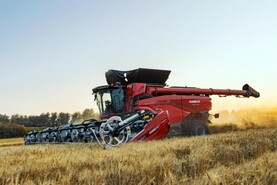With the mercury touching 29°C, the harvest kicked off on 19 July with the winter barley. As the temperature soared, the grain moistures quickly plummeted to around 14% and the combine’s air-con wasn’t working for the first three hours. There were clouds of dust billowing off the combine header.
Sweating like I’d run the marathon in Tokyo, I was delighted to get a call from the air-con man to say he was on the way.
He hopped out of his van already scratching with barley awns sticking to sweaty skin from his previous combine job with my neighbour Kealey’s classics. We all know, despite the compelling desire to itch your sweaty neck like a terrier with fleas, that you must resist the barley itch or you’ll go mad.
But being a Dub he had succumbed and was flittering his neck like a demented lunatic. Now he had to lie across a dusty and roasting hot combine engine to access the test ports.
I engaged with him to try to distract him in his torture. In a previous life he was an aircraft technician, rebuilding jet engines.
“Bet you never had this discomfort working above in cushy Team Aer Lingus,” I asked.
“Jaysus I did,” he quipped, “I got a lot bloody worse out of it – bleedin’ tinnitus from those noisy, ear-splitting hoors of jet engines.”
He had my sympathy as tinnitus can be an extremely unpleasant condition with a continuous, unending buzzing noise in your ears. It really could drive you mad and, in some cases, does.
The sticky heat became totally irrelevant. At least he would be very simply rid of the itching with an evening dip into the sea at Rush. That was his plan and with the repair completed, I wished him well, poor man.
First to fall to the combine’s knife was the six-row variety, Belfry, which produced loads of straw but the quality of the grain was so poor a trailer load of Rice Krispies would be heavier.
Six rows are always marginal (with us) and the best thing about Belfry is its hybrid vigour in wet autumn soils. Its very competitive growth pattern also usefully suppresses grassweeds.
Two-row Valerie followed, with much better quality which saved the day. But low bushel weights equate to unspectacular yields with an overall average of just 3.45t/ac. But I got the yield I deserved, as the barley had never looked good but perked up on the run into harvest, making me greedy.
I’m now less optimistic for the wheat than I was, as the nine days of over 28°C hastened its ripening, reducing valuable grain filling time. Cooler, non-continental-type summers are precisely the reason why we get higher wheat yields in Ireland.
The winter oats (Husky) were more satisfactory. With a decent bushel weight, a clean sample and beautiful white colour, it was good stuff for milling.
The yield was very satisfactory as well at 3.93t/ac but one oaten crop was spoiled by wheat volunteers. I chopped some of the huge crops of oaten straw under the Straw Incorporation Measure but most of it is for baling, whenever. We’ll chop the rape straw, as always. It’s too P and K rich to sell.
Demand outstripped supply with our barley straw but did it lead to higher prices? Yes, it did but, unfortunately, some straw buyers denigrate it as a cheap byproduct of cereal production which, of course, it’s not. The judicious sale of straw is an important income stream to the cereal grower. And there’ll be loads of it on the wheat crops. But some decent grain would be nice as well …






 This is a subscriber-only article
This is a subscriber-only article










SHARING OPTIONS: